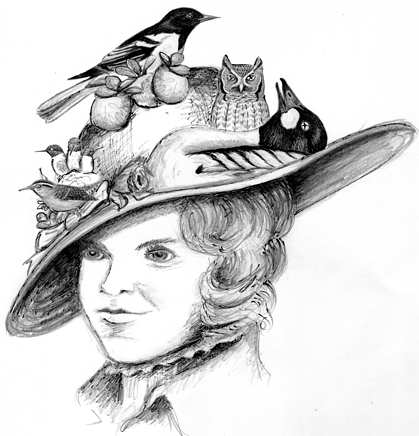
Dear Bird Folks,
I recently came upon a book with the horrifying title of “She’s Wearing a Dead Bird on Her Head.” The book turned out to be written for children, about the formation of the Audubon Society. After I left the store, I started thinking about this odd book. Have you ever heard of this book and do you know if the story is fictitious or is it based on real events?
-Margie, Muncie, IN
My Little Margie,
I’m not about to give you a hard time for reading the book in the store, instead of forking over the tremendous sum of $6.99 to buy the book. I do the same thing. But if you had flipped to the ending, like I always do, you would have known that yes, the book was indeed based on real events. Over one hundred years ago, fashionable women would wear hats that were so ridiculous looking that snowboarders would have been jealous. Only these so-called fashionable hats were made out of freshly killed backyard birds.
For hundreds of years people would wear a single plume on their hat. The feather-in the-hat design can be traced back to such fashion conscious notables as the Pied Piper and Yankee Doodle. Although the birds weren’t thrilled with this idea, the single plume was an arrangement that they could live with. Then, somewhere around the end of the nineteenth century, it all went wrong. Rich women decided that if one feather was cool then wearing the entire bird would make them downright happenin’. So instead of a plume or two, sometimes the entire bird was sewn onto the hat: feet, beak, gizzard and all.
Things were so bad that in 1886 one New York ornithologist stood on a Manhattan street corner and identified the birds that passed him on the sidewalk. The list included bluebirds, hummingbirds, orioles, warblers and owls. On that one day he counted 170 dead birds, riding on the tops of 170 hats, followed by 170 hungry cats.
Ten years later, a Boston socialite by the name of Harriet Hemenway, decided enough was enough. She called her cousin Minna and together they organized a series of afternoon teas. (For the rest of you, Harriet and Minna are the stars of the aforementioned book that Margie was too cheap to buy.) During these teas it was suggested to the other socialite women of Boston that birds could be better enjoyed sitting in trees than on the hats of the rich. The other ladies agreed and thus began the Massachusetts Audubon Society, the country’s oldest Audubon Society.
Harriet and Minna were not the minimalist earthy tree huggers of today. They were part of Boston’s respected upper crust. However, upper crust or not, they were still women and in 1896 women were anything but a powerful social force. They could not vote. Most women weren’t allowed to have meaningful jobs. And in many areas they weren’t even allowed to drive cars, although much of that had to do with the fact that cars hadn’t been invented yet. These woman may not have had much power, but their husbands were tremendously powerful and with their help the word was spread that the fashion industry was needlessly destroying our native bird population. Within months, other Audubon societies sprang up in other states, all voicing the same concerns. In 1900, four short years after Harriet and Minna had started their afternoon teas, the Lacy Act was passed. The Lacy Act, which banned the transportation of illegally killed birds across state lines, was the first of a string of victories for the preservation of our birds. The most powerful of these victories was the Migratory Bird Act of 1913. That act clearly saved many familiar birds from extinction.
Stopping the slaughter of birds might seem like a no-brainer today, but in 1896 shootin’ stuff was a way of life for many people. Killing birds for the millinery trade was a profitable business. The bird protection acts put thousands of people out of work. Not unlike the commercial fishing and logging battles of recent years, keeping birds off of hats in 1896 was not as cut and dry as it sounds today. It was not an easy task for the two non-voting, non-driving women from Boston.
With this one cause, Harriet and Minna were not only on the forefront of the conservation movement, but they also made a statement for the fledgling women’s movement. If turn-of-the-century women wanted to be taken seriously by their male counterparts, they could no longer walk around with a head-full of hummingbirds.
Luckily for our birds, the women of 2005 don’t feel as though they need to make any of the silly fashion statements like in years gone by. The females of today are quite content keeping things simple with low waisted jeans, tattoos and tongue bolts.